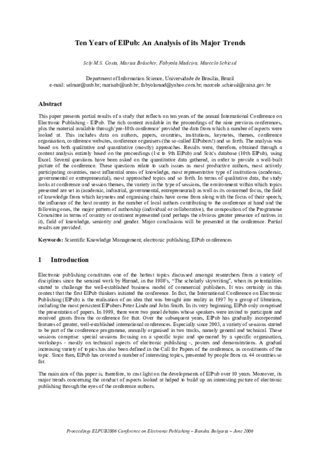This paper presents partial results of a study that reflects on ten years of the annual International Conference on Electronic Publishing – ElPub. The rich content available in the proceedings of the nine previous conferences, plus the material available through ‘pre-10th conference’ provided the data from which a number of aspects were looked at. This includes data on authors, papers, countries, institutions, keynotes, themes, conference organisation, conference websites, conference organisers (the so-called ElPubers!) and so forth. The analysis was based on both qualitative and quantitative (mostly) approaches. Results were, therefore, obtained through a content analysis entirely based on the proceedings (1st to 9th ElPub) and Scix’s database (10th ElPub), using Excel. Several questions have been asked on the quantitative data gathered, in order to provide a well-built picture of the conference. These questions relate to such issues as most productive authors, most actively participating countries, most influential areas of knowledge, most representative type of institutions (academic, governmental or entrepreneurial), most approached topics and so forth. In terms of qualitative data, the study looks at conference and session themes, the variety in the type of sessions, the environment within which topics presented are set in (academic, industrial, governmental, entrepreneurial) as well as its concerned focus, the field of knowledge from which keynotes and organising chairs have come from along with the focus of their speech, the influence of the host country in the number of local authors contributing to the conference at hand and the following ones, the major pattern of authorship (individual or collaborative), the composition of the Programme Committee in terms of country or continent represented (and perhaps the obvious greater presence of natives in it), field of knowledge, seniority and gender. Major conclusions will be presented at the conference. Partial results are provided.
Costa, Sely M. S., Marisa Bräscher, Fabyola Madeira, and Marcelo Schiessl. "Ten Years of ElPub: An Analysis of its Major Trends." In Digital Spectrum: Integrating Technology and Culture - Supplement to the Proceedings of the 10th International Conference on Electronic Publishing, 395-400. ELPUB. Bansko, Bulgaria, 2006.
